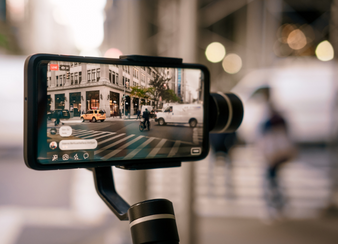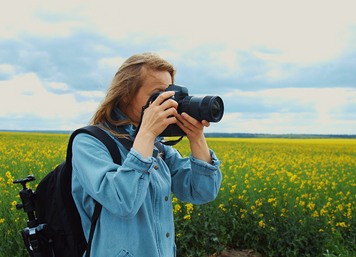How New Tech is Changing the Photography Industry in 2020
When we think about great pictures, we usually go back and remember old photos. But, photography hasn’t lost its quality over the years — it has improved. Something we must consider is that technology has brought innovation in photography. In the past, we would have never imagined that we would have 360º photographs. Maybe this was only a science fiction dream decades ago, but it’s a reality now.
Yet, 360º photography is not the only advancement in photography. Artificial intelligence (AI) is also playing a huge role in technology right now, and this trend is only going up. We can now add watermarks for free with software like watermarquee and we will continue to see advancement in tech photography in the next couple of years.
Because you are thinking about how new tech is changing the photography industry, we have looked into some of the most up-to-date tech trends in the photography industry, for you!
360º Photography
 360º photography is a method to take pictures from all angles.
360º photography is a method to take pictures from all angles.
Through its use, viewers will be able to see the picture in all directions, and some of them are so high-quality that no matter how much you zoom in, you’ll still see details. 360º photography has opened a strong trend among several e-commerce platforms like Amazon.
At first, people used to think this was a temporary trend, but apparently, it is here to stay. And although it is at its early stages, the tech is expected to be implemented in more marketing efforts.
Cinemagraph
The term refers to moving images similar to a video. You’ll often come across these on social media sites such as Reddit or Instagram. Cinemagraphs are often referred to as GIFs after its format (Graphics Interchange Format). A GIF isn’t necessarily a video, it is a picture with the illusion of movement.
Some creators have added moving elements to their photographs. The trend started because internet users didn’t want to continue seeing the same type of images repeatedly. Companies have also started to implement cinemagraphs in their marketing efforts because it appeals to their target audiences.
Cinemagraph won’t replace traditional photography but the use of GIFs and other types of cinemagraph techniques is a growing trend and more businesses have started to see the benefits.
Cloud Storage
 Today everything is data-driven, from pure file storage to even photography. It is widely known that almost all devices are connected to the internet, and cameras are no exception.
Today everything is data-driven, from pure file storage to even photography. It is widely known that almost all devices are connected to the internet, and cameras are no exception.
By saving pictures and videos in a cloud, photographers can make sure that their files are safely stored.
If any accident happens to their devices, their data will be safe.
But this isn’t just a matter of regular cameras, mobiles can also do this. Any picture you save on your phone could be instantly saved in the cloud. If you’re looking for a cloud service, there are some great ones like:
- Google Photos,
- Google Drive,
- DropBox,
- iDrive
Most of them have a free limited plan, but if you’re up to something bigger, you can always subscribe for more perks. Google Drive’s 100 GB storage plan is about $2 a month, which is not much considering you’ll be able to save so many photos.
Constant Connectivity
The fact that cameras are becoming less dependent on wires makes it easier for photographers to share files and save them in an online cloud. In the past, the only way to save and share your data was through a memory card, but this has drastically changed.
With the help of WiFi, Bluetooth, and Near-Field Connectivity (NFC), users can easily share their files in a matter of seconds, depending on the speed of your device.
Yet, this isn’t a perfect technology because it’s still limited. You can only share JPG files and not RAW images because they’re too heavy. However, technology can still be helpful if you want to share data with a client after a long day photoshoot. This will allow clients to preview some of the results before they’re edited.
AI-Driven Cameras
You may not know it, but AI has been working in cameras for a long time.
 Have you ever noticed that when you use your camera in the automatic mode, it recognizes faces?
Have you ever noticed that when you use your camera in the automatic mode, it recognizes faces?
Or that when you take a picture of a landscape, it automatically changes the exposure to make it more appealing? This last part is most common on mobile cameras than in regular cameras, but it’s still part of today’s photography trends.
AI is a great tool that can drastically enhance the look of our photographs. In the future, if we’d like to edit certain aspects of the photo, it’ll be much easier to find the spots we’d like to remove, for example. The photography editing software will automatically detect it for us, and we’ll spend time on more relevant tasks.
Smartphones Will Replace Compacts
Did you know that sales for compact cameras will fall for over 50%? And that in 2010, sales for digital cameras fell by 80%? These are some statistics by a recent report published by Cannon. The reason for this is because compact cameras don’t have anything that smartphones don’t offer. Smartphones are better than cameras by far.
They don’t only provide the same and even better photography quality, but they also have internet access, which makes it easier for users to store and share files. This will represent a significant change in the way the photography industry works, but the truth is it has been happening for years.
Digital single-lens reflex (DSLR) cameras will stay afloat because they provide users with the capability to manually change so many values, which gives them more freedom when taking pictures.
Yet, mobile cameras are now implementing the pro mode, which allows users to change the diaphragm and the exposure time of the image, simulating DSLR camera features. So we can expect that in the future, mobiles will reach the quality of DSLR without changing lenses.
In Conclusion
 Technology has surely transformed the way we do photographs; from 360º photography to AI-driven cameras, and even animated images. And the only thing we can expect is that it’ll continue to transform this industry.
Technology has surely transformed the way we do photographs; from 360º photography to AI-driven cameras, and even animated images. And the only thing we can expect is that it’ll continue to transform this industry.
Today, we’re also able to apply our own watermarks to our photographs with services such as WaterMarquee. This way, we can add our personal touch to every masterpiece.
Start watermarking today!

































